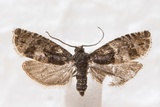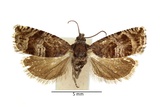Pammene luedersiana (Sorhagen, 1885) Species
Last modified: July 13, 2024, 5:56 p.m.
Discovered in the Belgian collection of E. Janmoulle from 1938 and then incorrectly identified as Cydia pactolana, not seen since then, but rediscovered again in 2023 in LX.
Details
- Classification
- Family: Tortricidae > Subfamily: Olethreutinae > Tribus: Grapholitini > Genus: Pammene > Species: Pammene luedersiana
- Vernacular names
- Gageldwergbladroller (NL)
- Status
-
Native
Distribution
Imago
Wingspan 11–12 mm. Ground color brownish grey with plenty of darker spots and streaks. Silvery transverse band just inside the middle that widens into a four-part lighter dorsal blotch. Ocellus with 2-3 long, black longitudinal stripes and it is bordered by silvery stripes on the sides and back.
The adults can be lured with the original pheromone of Grapholita funebrana.
Caterpillar
Body pinkish brown, sometimes almost colourless anteriorly with a reddish brown head, prothoracic plate black with a narrow medial line of body colour, inacula conspicuous, dark brown or dark blackish brown, black anal plate comparatively large, thoracic legs black,pale grey at joints, ventral and anal prolegs colourless, crochets reddish brown.
Bionomics
The larval habitation has a typical appearance consisting of a number of reddish or reddish brown withered terminal leaves and spun into tight, untidy tubes attached either to the stems or other leaves on the food plant. The wilted leaves are due to the caterpillar feeding on parts of the petioles attaching the leaves to the stems and the discoloration is caused by eating the parenchyma. Pupation outside of the larval habitation, usually amongst spun leaves or in the soil. Hibernates as a pupa.
The adults come to light and pheromones.
Flight periods
The adults are on the wing from late April towards June.
Observed on
- Host plant (species):
- Myrica gale and Vaccinium uliginosum
The larva feeds on Myrica gale, Vaccinium uliginosum and also probably on Rhododendron tomentosum.
Habitat
It inhabits peat bogs.


